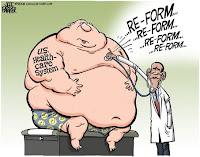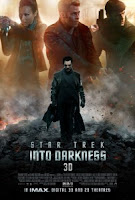
by Michael Handley (Updated Thursday July 25, 2013, 10:08 a.m. - U.S. Attorney General Eric Holder tells Texas,
maybe not, on immediate photo I.D. enforcement. Update noted below.)
On June 25, 2013, the Supreme Court struck down a part of the Voting Rights Act that required Texas and other states to get a federal DOJ or District Court approval before implementing any election law change.
The Court struck down Section 4 of the Voting Rights Act, the provision of the landmark civil rights law that designates which parts of the country must have changes to their voting laws cleared by the U.S. Department of Justice or a federal court. With Section 4 now invalidated, the states listed in Section 4, which includes Texas, are no longer compelled to comply with Section 5 preclearance requirements. Those states are now free to enforce laws previously blocked under Section 5 regulations.
On August 30, 2012, a federal DC Court three-judge panel blocked Texas' new
SB14 Voter Photo I.D. Law, under provisions of the Voting Rights Act struck down by the Supreme Court. The three-judge panel found that SB 14 imposed "strict, unforgiving burdens on the poor" and noted that racial minorities in
Texas are more likely to live in poverty.
The Department of Justice
pointed out that hundreds of thousands of registered voters in Texas were without the necessary identification and were thus at risk of disenfranchisement. A disproportionate number were Latino.
Justice Ruth Bader Ginsburg, dissenting from the June 25th SCOTUS ruling, highlighted a paradox at the heart of the majority opinion: “In the court’s view, the very success of Section 5 [and 4] of the Voting Rights Act demands its dormancy”.
Ginsburg, supported by justices Sephen Breyer, Sonia Sotomayor and Elena Kagan, said it is the very success of pre-clearance that underlines why it must be preserved. “The Voting Rights Act has worked to combat voting discrimination where other remedies have been tried and failed,” she writes.
In her dissent, Ginsburg lists some of the insidious changes to voting laws that could now creep back into the American electoral landscape. Under pre-clearance, states including Texas have been blocked from racial gerrymandering by redrawing electoral boundaries in an attempt to create segregated legislative districts.
Opponents of pre-clearance under Sections 4 and 5 of the Voting Rights Act say that Section 2 will be sufficient on its own as a safeguard against future discrimination. But the burden of challenging new electoral laws now shifts from the federal government to the individual voter.
Pamela Karlan, a professor at Stanford law school who had previously filed an amicus brief on behalf of the bipartisan House Judiciary Committee leadership supporting the constitutionality of Section 5 of the Voting Rights Act, said that by striking down pre-clearance the supreme court had “shifted the burden away from the perpetrators of discrimination and onto the shoulders of the victims of discrimination. Local minority voters will now have to find a lawyer and go to court to argue voting rights infringement under Section 2 – and for many that will be very difficult.”
Section 2 of the Voting Rights Act forbids states from enacting voting restrictions that have a greater impact on minority voters than on others. There is, however, a catch. Samuel Bagenstos, who was until recently the number two official in the U.S. Dept. of Justice Civil Rights Division, has said that the DOJ can't bring a Section 2 lawsuit claiming voter disenfranchisement, until after voters have been disenfranchised:
“In order to bring a Section 2 case, you’d have to as a practical matter show two things. One, that there’s a significant racial disparity and two, that the burden of getting an ID is significant enough for us to care about.
Any Section 2 case would almost certainly have to wait until after the next election, since the evidence that the laws were discriminatory “can only be gathered during an election that takes place when the law is enacted.”
Minority Leader of the House Rep. Nancy Pelosi (D-CA)
said Wednesday that Congressional Democrats are planning new legislation to render ineffective Chief Justice Roberts Court's decision on the Voting Rights Act. Congress must enact new Section 4 provisions that specify the states and localities that must seek election law preclearance under Section 5 requirements. But many question whether such legislation has any chance of passing in the Republican controlled House. (
How to Save the Voting Rights Act)
Shortly after the Supreme Court read its decision striking down Section 4 of the Voting Rights Act, Texas Attorney General Greg Abbott tweeted that nothing now stands in the way of the state enforcing its controversial SB 14 voter photo ID law.
“With today’s decision, the State’s voter ID law will take effect immediately,” Abbott announced. “Redistricting maps [as originally] passed by the Legislature [in the 2011 legislative session] may also take effect without approval from the federal
government.”
On Thursday, June 27, 2013 the Supreme Court followed up its Tuesday, June 25th, ruling on Section 4 of the VRA, officially vacating and kicking back the DC Court three-judge panel's August 2012 ruling that blocked Texas' voter photo I.D. law. SCOTUS' action was a predictable result of its ruling, effectively ending the federal government's oversight of elections in Texas and other states with a history of discrimination in voting. The justices ordered lower courts to reconsider, in light of Tuesday's ruling, the status of previous low court rulings on appeal to SCOTUS, as was Texas' I.D. law. Legal experts remain divided on what the Supreme Court's rulings mean for the election laws that had been blocked under Section 5 review, and it could be weeks before the district courts weigh in. The district three-judge panel courts, have several options, including restarting the arguments based on SCOTUS' Tuesday ruling, or weighing the case without additional briefing. In the mean time, Texas and other states listed in Section 4 are
not waiting to start enforcement of those laws. Yet, states with a district court or DOJ judgment against them, must clear that judgment to be before the law can be enforced.
U.S. Rep. Marc Veasey (D - Fort Worth) joined seven others Wednesday in
filing a federal lawsuit to keep Texas from enforcing its voter ID law. Veasey, who represents the 33rd Congressional District, one of four districts created statewide during the latest redistricting battle, filed the papers in Corpus Christi federal court saying that under Section 2 of the VRA, SB 14, which requires voters to present a government-issued photo I.D. at polling places, will unconstitutionally deprive thousands of minorities of their right to vote and make re-election campaigns more expensive.
Sections 3 of the Voting Rights Act could possibly provide the same protections afforded under Sections 4 and 5. Section 3 of the VRA contains a "bail-in" process by which jurisdictions outside the coverage formula of Section 4 that violate other provisions of the Voting Rights Act may become subject to preclearance. Unlike Section 5 preclearance, the period of coverage is based on a ruling or consent decree issued by a federal court, and the scope of coverage may be limited to particular types of voting law changes. Although the Supreme Court held the coverage formula of Section 4 unconstitutional in its Shelby decision, it did not hold Section 3 unconstitutional; thus, bailed-in jurisdictions remain subject to preclearance.
Lyle Denniston of ScotusBlog.com explains it saying:
"There is another provision of the law, potentially a back-up (Section 3), that allows the government to go to court to ask that a new state or local government be put under Section 5 because of its more recent history in dealing with minority voters. Two states have been brought under Section 5 that way--Arkansas and New Mexico--along with several county governments, including Los Angeles County in California. The Court's main opinion did not even mention Section 3, but the dissenters referred to it briefly as a "bail-in mechanism" that has worked. If a challenger now seeks to employ that provision, it presumably will have to show that bias is still a present-day problem there."
In a 2010 Yale Law Journal article,
Travis Crum called Section 3 "The Voting Rights Act's secret weapon," one that "the academic literature has ignored":
Commonly called the bail-in mechanism for pockets of voting discrimination, Section 3 authorizes federal courts to place states and political subdivisions that have violated the Fourteenth or Fifteenth Amendments under preclearance. Designed to trigger coverage in "pockets of discrimination" missed by section 5's formula [sic; the formula is actually defined in Section 4], section 3 was included in the original Voting Rights Act.
Preclearance under Section 3 does not suffer from the constitutional infirmity that doomed Section 4. It requires a contemporary factual finding of discrimination, either a decision by a judge or an acknowledgment by the defendant jurisdiction. That is to say that even absent congressional action, preclearance remains among the tools available to the Justice Department and voting-rights advocates. They just have to prove their case before using it. In 2012, a federal court ruling in the Texas' redistricting case and another federal court ruling on Texas' restrictive voter photo I.D. law found that Texas lawmakers passed legislation related to each case that had "the intent and effect" of discriminating against minorities.
In the VRA Section 5 review of Texas'redistricting legislation, the
federal three judge panel said it was “persuaded by the totality of the evidence that the plan was enacted with discriminatory intent,” according to the ruling. There was “sufficient evidence to conclude that the Congressional Plan was motivated, at least in part, by discriminatory intent,” the court found. The three judges said they were overwhelmed with the amount of evidence showing the congressional redistricting plan was intentionally discriminatory, writing in a footnote that parties “have provided more evidence of discriminatory intent than we have space, or need, to address here.” The Justice Department could refer to those two court findings to ask a federal court to "bail" Texas back into a preclearance regimen for updates to election laws and procedures.
Update July 25, 2013 @ 10:08 a.m. CDT -
U.S. Attorney General Eric Holder announced today that the Justice Department will invoke Section 3 of the VRA in the battle for voting rights that could block Texas from enforcing its strict voter photo I.D. law. Quote Holder, "And today I am announcing that the Justice Department will ask a federal court in Texas to subject the State of Texas to a preclearance regime similar to the one required by Section 5 of the Voting Rights Act. This request to “bail in” the state – and require it to obtain “pre-approval” from either the Department or a federal court before implementing future voting changes – is available under the Voting Rights Act when intentional voting discrimination is found. Based on the evidence of intentional racial discrimination that was presented last year in the redistricting case, Texas v. Holder – as well as the history of pervasive voting-related discrimination against racial minorities that the Supreme Court itself has recognized – we believe that the State of Texas should be required to go through a preclearance process whenever it changes its voting laws and practices." Click here for full text of Holder's speech:
The Justice Department will make Section 3 related filings, announced by Holder, with the the San Antonio U.S. District Court three-judge panel that controls Texas' not yet concluded interim redistricting map case, that originated in late 2011. The Justice Department will likely also join the with Congressman Marc Veasey and others in their suit filed in a Corpus Christi federal court to stop implementation of the SB14 voter I.D. law. It may take some time for the Section 3 technical legal maneuvering to play out, which may or may not result in the SA Court deciding that Texas should be bailed-into the preclearance regimen under Section 3. The court may or may not decided to block Texas' enforcement of its voter photo I.D. law, while the Section 3 bail-in question is under consideration. Even if Texas is again bailed into the preclearance regimen, it would likely take additional court maneuvering to deal with the voter SB14 voter I.D. law. For now, at least, Texas can continue plans to enforce its voter photo I.D. law for the Texas Constitutional Amendment Election in November 2013 and the 2014 primary and general elections.
Originally set to go into effect on January 1, 2012, the Texas Photo I.D. Law (
SB14) requires voters to present one of a limited selection of
government issued photo I.D. to election Judges in order to qualify to
vote. The accepted forms of currently dated photo identification include:
- Texas DPS issued Driver’s License or Personal Identification Card;
- Texas DPS issued Election Identification Certificate (EIC);
- US passport;
- US military ID;
- Texas concealed weapons license; or
- US citizenship papers containing a photo.
For those who do not have an unexpired government issued photo I.D., the law contains a provision that requires the Texas Driver's License office to issue special "Election Identification Certificates" free of charge to citizens. Of course, a person seeking a free EIC at the Driver's License Office must present a state certified birth certificate and other I.D.'s. Obtaining those identity documents, for those who don't already hold them, can be costly to a near impossibility. (see -
Texas A Step Closer To Federal Real I.D. Act and
War On Terror "Real I.D." Driver's License Federal Law Meets State Voter Photo I.D.)
To qualify to vote, their is no requirement for the Election Judge or Clerk to determine that the photo on the voter's I.D. substantially resembles the voter, but SB14 does require that
the name on the I.D. is substantially the same name listed in the poll book.
Voters who present a driver's license, pass port, citizenship certificate or
other photo I.D. to the election judge that has a different first,
middle, and last name than appears on the poll list, the voter has a
problem. How big of a problem depends on how much the names vary
between the I.D. and the poll list.
Only 66% of women have an I.D. that reflects their current name. Newlywed
women often update their driver's license with their new married name,
but neglect to update the their voter registration and other documents. Many married women
use their maiden name as their middle name on some documents, especially
their driver's license, and use their given middle name in other
circumstances, like registering to vote, or vice versa. Some married
woman adopt a hyphenated last name that combines their maiden last name
and husband last name, but not uniformly on all documents. Asian-American women who are naturalized citizens often adopt an Americanized name on many documents, like registering to vote, but that name
isn't the same as on their citizenship certificate.
A
mismatch on just the middle name between the I.D. and poll list will definitely result in the voter being
required to complete an affidavit attesting to their true identity. A
newlywed woman who presents a driver's license with a different middle
and last name as printed on the poll list may be require to vote a
provisional ballot at the polling place and then travel to the county elections office one to
six days after Election Day to present proof of her identity.
The Texas Department of Public Safety announced shortly after the Supreme
Court read its decision that starting Thursday, June 27, 2013, Texas driver license offices will begin issuing free Election Identification Certificates to anyone who doesn't already have another of the government issued photo I.D. documents. (DPS Webpage for EIC Info.)
Under the 2011 state law creating one of the state’s most strict voter I.D. laws, the certificates are free and valid for six years - which means they must be periodically renewed.
However, there is no expiration date of an EIC for citizens 70 years of age or older.
To qualify for any Texas Department of Public Safety issued photo I.D., an applicant must give proof of U.S. citizenship and Texas residency by presenting identity documents. These identity documents include an unexpired Texas driver license, Texas Identification card, or U.S. Passport book or card. For most who don't have one of those primary identification documents, already, they must present an original or certified copy of a birth certificate issued by their birth state's Bureau of Vital Statistics, along with another identity document listed under a menu of documents. This menu of documents includes a Voter Registration Card.
Frequently Asked Questions:
 Two years ago I wrote an article for the Dem Blog News that said, in part:
Two years ago I wrote an article for the Dem Blog News that said, in part: 















